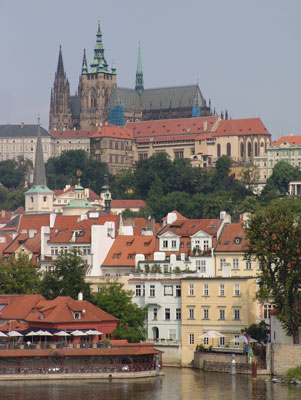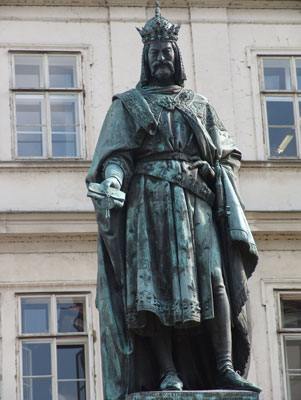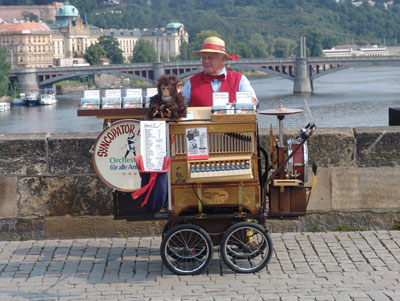In search of Prague’s famed emperor
by Harvey Hagman, Fort Myers, FL
Prague has seen it all, from the grandeur of the Holy Roman Empire to the rise and fall of the Hapsburgs and on through the terror and neglect of the Nazis and the Communists.
Yet, by a miracle, it has survived.
Look down any street and a Baroque building pops into view, then another and another. Behind them, church spires soar. This architectural wonderland continues on as visitors’ feet ache against the cobblestones.
But, as my wife said of Prague, “The more I walk it, the more I like it.”
Prague’s Charles IV
This hilly city of domes, spires, red tile roofs and steep stairways bustles and rumbles as trams and cars race over cobblestones, creating a 24-hour cacophony in the mildly polluted air.
We focused our June ’08 visit on the legacy of Charles IV, the father of the Czech nation. During the Middle Ages, Prague enjoyed a golden age — especially during the 30-year reign of Charles, who was elected Holy Roman Emperor at the age of 14. Under this wise, cultured king, Prague grew into a magnificent city, larger than Paris or London.
Under Charles, Prague became famed for its architecture. He rebuilt St. Vitus Cathedral at Prague Castle and built the stone Charles Bridge to replace the Judith Bridge that collapsed in a flood. But it is said he was most proud of founding Prague’s university, the Carolinum, in 1348, the first of its kind in Central Europe.
Charles founded Prague’s New Town in 1348. It was carefully laid out around three marketplaces: the Hay Market, the Cattle Market (Charles Square) and the Horse Market (Wenceslas Square).
Many of the fine Gothic churches and monasteries initiated by Charles still stand.
Exploring the city
We started our search for Charles’ legacy on foot — the best way to enjoy Prague. Our quest began at Prague Castle and the Cathedral of St. Vitus, whose glorious stained-glass windows, rising to the Gothic ceiling, dazzled us. Both were built at Charles’ behest along with his shrine to St. Wenceslas, St. Wenceslas Chapel.
We each got an audio guide and tickets allowing admission to all castle area buildings for $29 — not cheap but well worth it for the fascinating stories. This allowed us to take our time examining the chapels, art and sarcophagi of St. Vitus as the crowds pressed on.
The audio guide covered the Old Royal Palace, the story of Prague Castle, St. George’s Basilica, the Convent of St. George, the National Gallery, the Golden Lane and the Powder Tower.
Below the cathedral’s stone floor lies the royal crypt. The center sarcophagus is the final resting place of Charles, and the remains of Charles’ four wives are in the back row, all in one sarcophagus.
After the cathedral, the nation’s spiritual heart, we visited the Castle Museum with its exhibits dating from prehistory to the present. Then we broke for a 75-minute matinee concert featuring a pianist, a flutist and a violinist playing Mozart, Bach, Vivaldi, Dvorˇák and Smetana in the castle’s Lobkowicz Palace.
Later, we made our own procession down the Royal Route, a downhill stroll from Prague Castle that took us through Malá Strana (Lesser Town) and across the Charles Bridge to Old Town Square, a trip that recalled the route taken by carriages of Bohemian kings.
Charles’ architectural legacy
Off the Old Town Square stands the famed Ty´n Church, built in the 1380s, with its double, square towers topped by black steeples. Unfortunately, it was closed for restoration.
Part of the ornate Charles Bridge was also under repair, but it still offered a wondrous walk in the early morning. Its 30 statues, many blackened as their sandstone is porous, each has its own history.
Artists were setting up their works and musicians were tuning up for the day. We enjoyed the fine views of the Lesser Town, fishing boats on the river and the spectacular view of Prague Castle from this 14th-century bridge that has withstood wars and floods.
At one end, the magnificent Gothic Old Town Bridge Tower was made for Charles by the architect who drafted plans for the St. Vitus Cathedral. This fitting companion of the bridge is part of the Old Town fortifications. It depicts the coats of arms of Charles’ territories.
Across the river lies the forested Petrˇín Hill, where the ruins of the 20-foot-high Hunger Wall run for more than half a mile, complete with crenellated battlements and a platform for archers. Built in the 1360s, it was ordered, some say, by Charles as a welfare project to provide work for the city’s starving poor.
Later we climbed the Powder Tower to admire the nearby neo-Gothic spires.
Soaking up the atmosphere
A day later, a 30-minute train ride took us to Karlstejn Castle, built by Charles in the 14th century as a retreat. It also served to protect the crown jewels and stood as a symbol of his divine right to rule the Holy Roman Empire. This hilltop bastion rises majestically on a crag above neat vineyards, lush forests and the Berounka River.
We enjoyed the climb of the castle’s ramparts, getting spectacular views, then toured the palace, hall of knights, chapel, bedroom and audience halls.
There was much more to Prague and we lingered for seven days, visiting the National Museum, the National Gallery, the Old-New Synagogue, the Church of St. Nicolas, the Old Town Hall, Wenceslas Square, the Alfons Mucha Museum, the Municipal House and the Powder Gate. Prague’s museums, though small, were gems.
Only the medieval astronomical clock, with figures parading at the top of the hour, disappointed. The figures were small and hard to see and could be viewed only from a narrow, always-overcrowded street, making it impossible to get a good view.
To unwind, we descended the Charles Bridge stairs to wander the Lesser Town and its quiet, green Kampa Park. Sitting on benches, we soaked up the romantic views of fishermen, the river’s falls and the spires, domes and palaces in the distance.
We quaffed tasty, cheap pivo (beer). It should be good, since the Czechs have 500 years of brewing experience. Often we wound up the day with one at the local pub, Hospudka, located below the William Hotel, where we began to recognize the regulars.
But, always, the ghost of Charles remains whenever we recall our time in munificent Prague.



